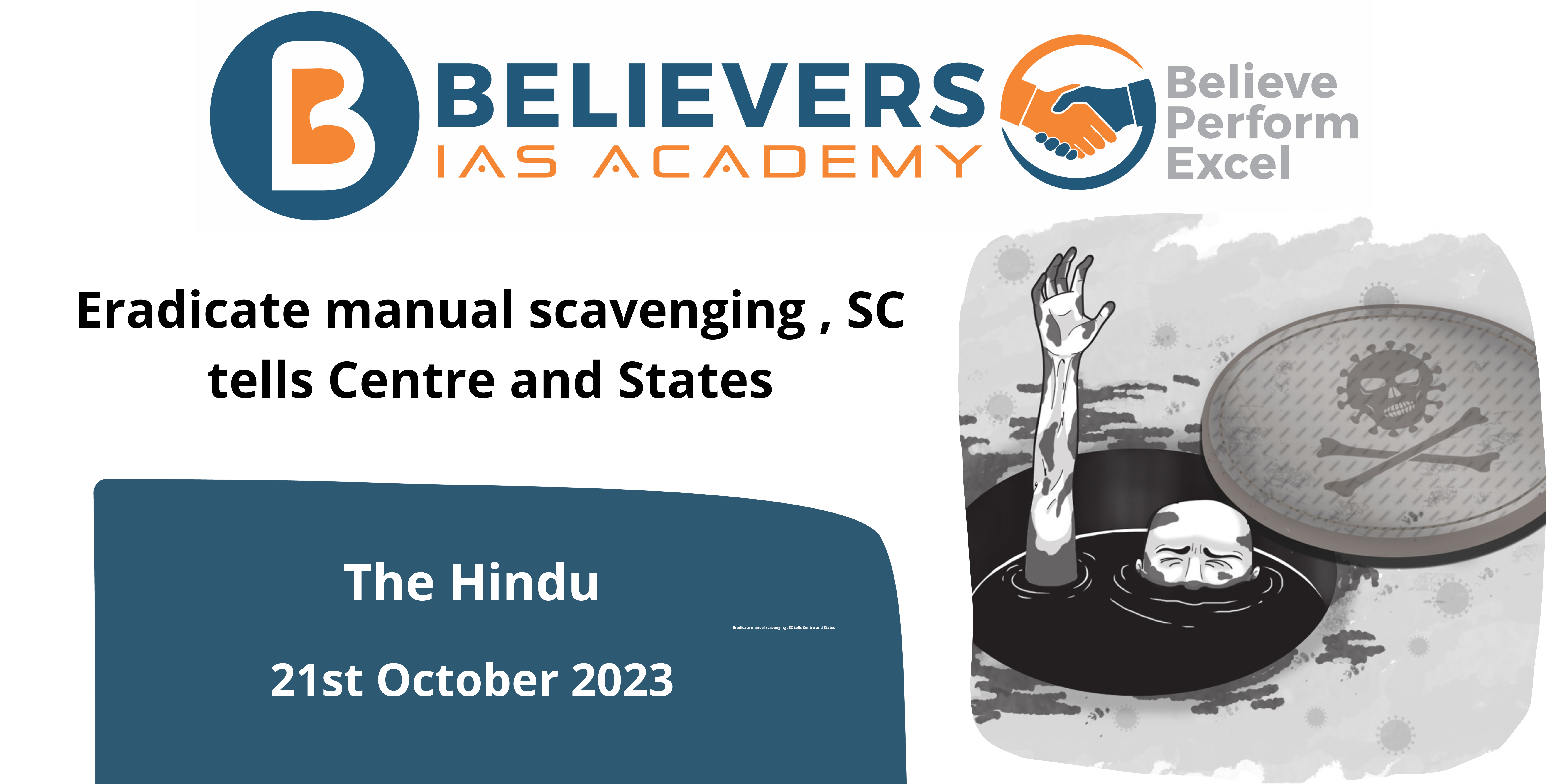Eradicate manual scavenging , SC tells Centre and States
Context
The Supreme Court declared on Friday that, even ten years after the cruel practice of manual scavenging was outlawed, claims of fraternity, equality, and dignity among citizens remain merely theoretical if a sizable portion of the populace is still forced to live in sewers and perish there.
What is the practice of manual scavenging?
- The act of manually handling, cleaning, and discarding human feces and other waste products is known as “manual scavenging.” It comprises:
- Cleaning sewers, open drains, and dry urinals
- cleaning and maintaining gutters, sewers, and septic tanks
- removing pee and feces from humans and animals from dry toilets
- Hand instruments like shovels, brooms, and buckets are typically used by manual scavengers.
- In India, manual scavenging has been outlawed since 1993. Still, there are still some regions of the nation where it is used. There were 58,000 manual scavengers in India as of 2018.
- Uttar Pradesh was found to have the greatest number of manual scavengers in a single state, with 20,884.
- Scavenging by hand is a compulsory profession that is based on caste. The issue still exists because:
- Insufficient opportunities for employment in the future
- enduring societal shame
- Many families of laborers who lost their lives while performing manual scavenging do not receive payment.
Which is the constitutional act that bans the practise of manual scavenging from India?
- The usage of manual scavengers is forbidden by the Prohibition of Employment as Manual Scavengers and their Rehabilitation Act, 2013 (PEMSR). The rehabilitation of manual scavengers and their families is also covered under the act. On December 6, 2013, the act became operative.
- The 1993 Act is replaced by the 2013 Act. All excrement, including that from pits, open sewers, and unsanitary latrines, cannot be manually cleaned under the 2013 act. Additionally, the statute criminalizes and punishes paying someone to perform physical scavenging work.
- The 2013 act was passed in order to end discrimination against caste in manual scavenging.
What is the reason behind Manual scavenging being banned?
- Human Dignity Violation: Manual scavenging entails the manual removal of excreta and human waste from sewers and dry latrines. This behavior is cruel, dehumanizing, and an outright violation of the dignity of individuals who engage in it. Limiting manual scavenging is a crucial measure in protecting these people’s rights and dignity.
- Equality and Social Justice: In India, manual scavengers are frequently from underprivileged and marginalized communities, where they experience prejudice and social exclusion. Eliminating the injustice and exploitation individuals experience via the practice of manual scavenging is a step toward achieving social justice and equality.
- Health Risks: Workers who perform manual scavenging run a serious risk of illness. Because of the unhygienic conditions in which they labor, they are highly susceptible to catching infections. It is imperative to outlaw manual scavenging in order to safeguard the health of individuals who engage in this activity.
- Safety Issues: Manual scavengers frequently operate in hazardous settings, such as cramped quarters and poisonous areas, which present serious safety risks. The purpose of the restriction is to safeguard employees from harm and death.
- Law: To outlaw manual scavenging, the Indian government has passed legislation. A legal framework for outlawing and eliminating manual scavenging is provided by the Construction of Dry Latrines (Prohibition) Act, 1993, and the Prohibition of Employment as Manual Scavengers and their Rehabilitation Act, 2013.
What is the viewpoint of Supreme Court in the case of manual scavenging?
- Prohibition and Ban: The Supreme Court has maintained India’s legislative prohibition against manual scavenging, acknowledging that it is an inhumane and cruel practice that diminishes the dignity of individuals engaged. According to the Court, outlawing manual scavenging is a necessary step in defending the rights and dignity of those who engage in this practice.
- Government Accountability: The Court has regularly ruled that the Union (Central) and State governments bear equal responsibility for seeing to it that manual scavenging is totally eliminated. It highlights that the government must actively work to end this practice and strictly enforce the 2013 Rehabilitation Act and the Prohibition of Employment as Manual Scavengers.
- Human Dignity and Equality: According to the Supreme Court, manual scavenging directly violates the concepts of equality and human dignity. It views the defense of equality and the preservation of human dignity as essential goals that ought to direct efforts to end manual scavenging.
- Raised Compensation: The Supreme Court has raised the amount of money awarded for sewage deaths, acknowledging the dangers manual scavengers endure and the terrible outcomes that might transpire in their line of work. This indicates the Court’s opinion that the families of individuals engaged in manual scavenging should get just recompense.
Conclusion
The Supreme Court’s statement highlights the difficulties in completely ending manual scavenging and urges greater action to safeguard the rights and dignity of individuals who work in this dangerous field. In order to completely eradicate this dehumanizing practice, it highlights the necessity of not only legal measures but also of effective enforcement, societal awareness, and manual scavenger rehabilitation.




